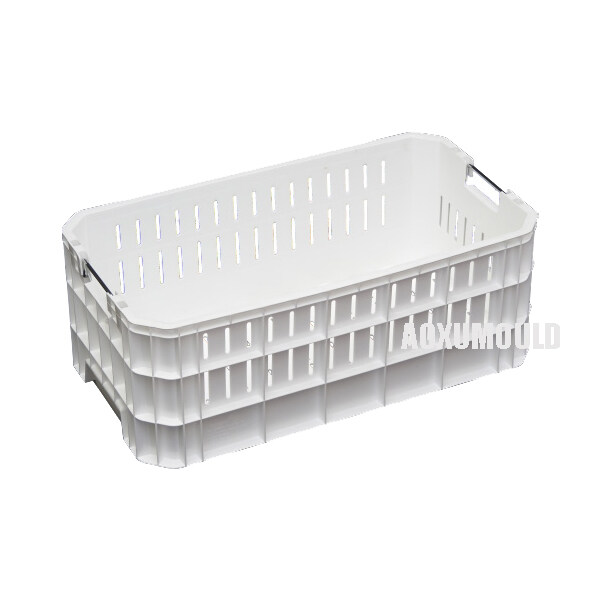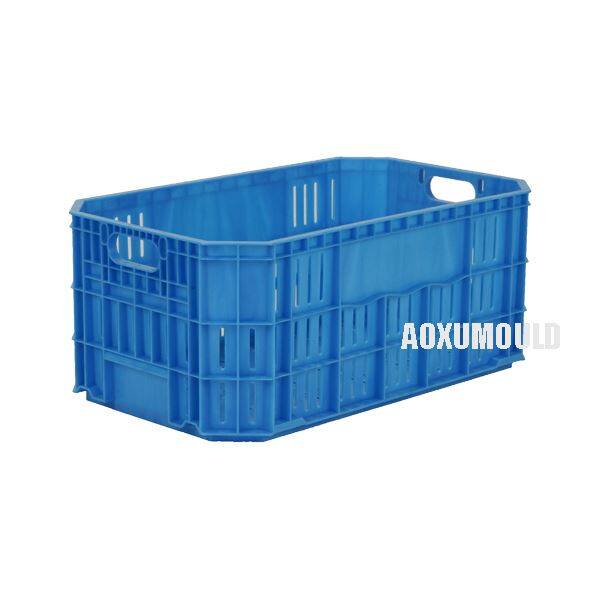Mould Specifications
|
Mould name |
Hands-free Crate Mould |
|
Product material |
PP, plastic |
|
Product Size |
510X305X210mm |
| Product Weight | 15KG |
|
Mould material for cavity &. Core |
P20, 718, 2738 |
|
NOs of cavity |
1 cavity |
|
Injection system |
Hot runner |
|
Suitable injection machine |
650T |
|
Mould size |
900X580X600mm |
|
Mould lifetime |
more than 500,000pcs |
Features Of Hands-free Crate Mould(with metal handles)
1.Hybrid Metal-Plastic Construction
Metal handles (typically steel or aluminum) are insert-moulded into the plastic crate
Provides superior load-bearing capacity vs. all-plastic handles
Allows automated production while maintaining structural strength
2.Full Automation System
Robotic arms precisely insert metal handles into the mould before injection
Automated quality control checks handle positioning
Vision systems verify proper metal-plastic bonding
3.Reinforced Mould Design
Specialized cavities for metal component integration
Enhanced cooling around metal inserts to prevent warping
Durable mould materials to withstand metal-plastic interface stresses
4.High-Precision Production
Tolerance control within ±0.1mm for perfect handle alignment
Multi-cavity options (typically 2-4 cavities) for mass production
Cycle times optimized for metal insert handling
5.Production Process:
Metal Handle Feeding - Automated system loads handles into mould
Plastic Injection - Molten plastic bonds to metal components
Cooling & Ejection - Specialized system removes hybrid crate
Quality Verification - Checks metal-plastic adhesion integrity
Key Benefits of Metal-Handle Crates vs. All-Plastic Crates

1. Superior Strength & Load Capacity
Metal handles withstand 3-5x heavier loads (e.g., 100+ kg per crate vs. 30-50 kg for plastic handles).
Ideal for automotive, construction, or military applications where heavy payloads are common.
2. Enhanced Durability
No handle breakage from impacts or fatigue (common in all-plastic designs).
Metal resists UV degradation, chemicals, and extreme temperatures better than plastic.
3. Automation & Ergonomics
Robots grip metal handles more securely (suction or magnetic pick-up possible).
Ergonomic for workers – Reduced strain during manual lifting vs. sharp plastic edges.
4. Longer Lifespan
Lasts 2-3x longer than all-plastic crates in high-use environments (e.g., warehouses, factories).
Metal components don't warp or weaken over time like plastic.
5. Safety & Compliance
Fire-resistant (metal handles won't melt in high-heat conditions).
Meets military/industrial safety standards (e.g., MIL-SPEC, ISO 18613).
6. Cost Efficiency Over Time
Lower replacement costs – Fewer cracked/broken handles mean reduced downtime.
Recyclable metal inserts can be reused or repurposed.
7. Customization Flexibility
Hybrid designs allow metal handles with lightweight plastic bodies (best of both worlds).
Options for foldable, removable, or reinforced handles to match use cases.
How Does The Automation Process Work?

1. Metal Handle Insertion (For Hybrid Crates)
(Skip this step for all-plastic handles)
Robotic arms pick and place pre-fabricated metal handles into the mould cavities.
Vision systems verify correct positioning before injection.
2. Plastic Injection Moulding
Molten plastic (PP/HDPE) is injected into the mould at high pressure.
For metal-handle crates, the plastic bonds around the inserts for a seamless grip.
Cooling channels solidify the crate structure (extra cooling near handles).
3. Automated Ejection
Ejector pins or tilting mould mechanisms release the crate.
Robotic grippers (suction/vacuum or mechanical claws) securely grab the integrated handles to remove the crate.
4. Post-Moulding Handling
Conveyor belts transport crates to stacking/packing stations.
Robotic stackers auto-palletize crates in optimized patterns.
5. Quality Control (QC)
Vision cameras inspect handle alignment and structural integrity.
Weight/load testers verify handle strength (for metal inserts).
6. Optional Add-Ons
In-Mould Labelling (IML): Branding applied during moulding.
RFID embedding: Track crates via smart tags.
Designs For Product &. Mould

Mould Components
Mould Steel

Hot Runner System

Standard Parts

Package &. Delivery

Maintenance Guide for Hands-free Crate Moulds
1. Daily Maintenance
>Clean Cavities & Handles Area
Use compressed air or soft brushes to remove plastic residue.
Avoid metal scrapers that could damage the mould surface.
>Lubricate Moving Parts
Apply high-temperature grease to ejector pins, sliders, and handle-insert mechanisms.
Check for smooth operation of tilting mechanisms (if used).
>Inspect Handles (Metal/Plastic)
Verify no cracks, warping, or misalignment in handle areas.
For metal inserts: Check for rust or coating wear.
2. Weekly Maintenance
>Deep Cleaning
Disassemble and clean cooling channels to prevent clogging (use descaling solutions).
Polish mould surfaces with non-abrasive compounds to maintain gloss.
>Check Wear & Tear
Measure ejector pin lengths – Replace if worn beyond tolerance (±0.05mm).
Inspect handle-insert guides for deformation.
FAQ
>1. What is a Hands-Free Crate Mould with Metal Handles?
It's an automated injection mould that produces heavy-duty plastic crates with integrated metal handles (steel/aluminum). The process combines insert moulding for durability and robotic automation for high-efficiency production.
>2. What industries use these crates?
Automotive parts logistics, Military/defense storage, Construction material handling and Heavy-duty agriculture transport.
>3. Can the hands-free crate mould with metal handles be customized?
Yes, the hands-free crate mould with metal handles can be customized according to the specific requirements and dimensions of the customer.
>4. How long does it take to manufacture a hands-free crate mould with metal handles?
The manufacturing time for a hands-free crate mould with metal handles can vary depending on the complexity of the design and the quantity ordered. However, most orders can be completed within 55days.
>5. Can the hands-free crate mould with metal handles be used for outdoor storage?
Yes, the hands-free crate mould with metal handles is suitable for both indoor and outdoor use, making it a versatile storage solution.
>6. How does the automation process work?
Robots pre-place metal handles into the mould.
Plastic is injected, bonding to the metal.
Automated QC checks handle alignment.
Robotic arms remove finished crates via the metal handles.
>7. What plastics work best with metal handles?
Glass-filled polypropylene (GFPP) – Best for strength
High-Density Polyethylene (HDPE) – Impact-resistant
Polycarbonate (PC) – For extreme conditions
Customers' Feedback












